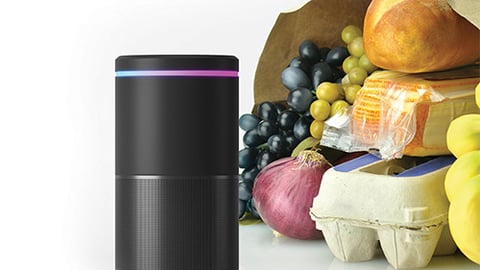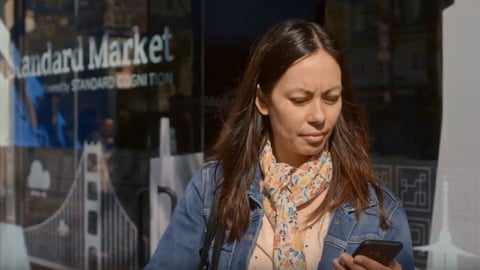Checkout-Free or Cashierless Technologies Inch Closer to Grocery Implementation
Key Takeaways
- Cashierless technology could be the answer to the frustrations often experienced by supermarket shoppers when checking out their groceries.
- Various checkout-free technologies that are now available aim to maximize benefits for both the retailer and customer.
- Improved customer service, lower shrink and an abundance of data are pluses for retailers, while customers enjoy a seamless, convenient, more personalized shopping experience.
When the first Amazon Go store opened to the public in January 2018, the concept seemed magical to many. Shoppers can walk into the store; grab whatever they’d like; put it in coat pockets, bags or elsewhere; and simply walk out. All the customers need is an app.
Fast-forward not even two years, and Amazon plans to open 3,000 cashierless stores, with many other players entering the category in a big way. These tech companies have their sights not only on 2,000- or 3,000-square-foot convenience stores, but also on grocery stores 10 times that size or larger.
Grocery has long tried to solve the friction of the checkout experience. From opening more registers to implementing self-service kiosks, no solutions have yet to fully satisfy both the retailer and the customer.
“The problem has been known for a while that the checkout experience has been steadily becoming more and more frustrating, starting from the time when barcodes were introduced,” says Krishna Motukuri, CEO of San Francisco-based checkout-free technology company Zippin. “As labor costs go up and retailers face intense pressure on their margins, it’s only gotten worse.”
Checkout-free technology could be the answer. In Phononic’s “2019 Store of the Future Report,” nearly nine out of 10 Americans (86 percent) said that mobile apps will allow people to scan groceries as they shop and then pay through an app in the next five years.
“Right now, what we’re seeing in grocery is kind of this transition where experience really matters for the end user,” says Ahmed Beshry, co-founder of Caper, a Brooklyn, N.Y.-based provider of smart shopping carts. “Unlike 10 years ago, if I’m in a grocery store and the experience is bad, I don’t have to go through the whole painful process of waiting in line.”
As checkout-free continues to inch closer to traditional grocery, these technologies aim to maximize benefits for both the retailer and customer.
“No. 1, there is a new level of acceptance of technology in retail spaces, because grocers are looking to differentiate and create a better shopper experience,” says Andy Radlow, chief marketing officer for Berkeley Calif.-based checkout-free technology company Grabango. “The second thing is that this introduction of technology is heightening competition, and that competition is very bottom-line driven.
“You’re talking about businesses on a legacy basis that are 1 to 3 percent net-profit businesses, but very high-revenue businesses,” Radlow continues.
Different Form Factors
All three of the companies quoted above, along with other large players in the industry, offer different checkout-free technologies. Let’s look at Caper, Grabango and Zippin’s most fundamental attributes as options for grocers to retrofit their existing stores.
Caper uses a smart shopping cart with built-in sensors. Customers currently scan the item and place it in the cart, with a screen on the cart keeping track of purchases and interacting with shoppers. Item recognition is also in the works to replace the need to scan.
“When I talk about the simplicity of rolling out our product, the retailers don’t need to put a single screw into their walls, and for shoppers, they do not need to download a single app.” Beshry says.
Grabango, which is working closely with three of the top 30 grocers on Progressive Grocer’s Super 50 list and one of the top 10 convenience stores, assigns every shopper a “virtual basket” when they walk through the door. The technology company uses a proprietary hardware, called “G rails,” which includes a high number of low-cost sensors lined up and down the aisles.
“[The G rails] almost look like a fluorescent lamp fixture, and we colorize them to match the color tone designed by the store, so they truly disappear into the ceiling of the retail store itself,” Radlow says.

Zippin, which operates an Amazon Go rival store in San Francisco to display its technology, has a cashierless system that uses multiple sources of information, both cameras and shelf sensors, to triangulate and receive the correct information.
“All of our technology is designed to be retrofitted into existing stores, so our hardware choices — specifically how the sensors and cameras work — are designed to work with existing stores’ power and internet infrastructure,” Motukuri says.
Retailer Advantages
There are a number of reasons retailers may find checkout-free systems to be the answer to increased profits, including, but not limited to, fewer employees behind the register, a reduction in theft by fraud, and new customer data like they’ve never had in the past.
In a cashierless system, retailers will have to pay fewer people to stand behind the register, and can instead empower these employees on a different level.
“Any second their employee stands at a grocery store checkout and scans product is actually a waste for the retailer. In fact, many retailers try to make the best of it and have the cashier ask if they found everything, but in reality that’s too late in the experience,” Motukuri says. “We think that grocers will be better able to use their employees by having them provide more customer service and help with the discovery of products much earlier in the shopping experience, when customers enter and are walking the aisles.”
Employees will still need to approve some items, however, such as alcoholic beverages, before customers exit the store.
Also, whether it’s a 1 percent or a 4 percent revenue issue for a store, shrink can wreak havoc on a grocer with already tight margins. With camera-based checkout-free systems, shrink by fraud is nearly eliminated.
“Hiding a product or products on your body no longer exists,” Radlow asserts. “Every product is associated with somebody when it makes its way out of the store, whether you’re a customer or a worker at the store.”
Another benefit of these technologies in the stores is a large amount of data that retailers can use to maximize square footage, improve the shopper experience and boost sales.
Zippin’s system of shelf sensors and cameras knows what’s on every shelf, meaning that it can notify retailers immediately when a shelf is running out of a product, or when a customer has misplaced a product or put it on the wrong shelf.
Difficult-to-Handle Items
Grocery is a highly dynamic retail environment with end caps changing on a regular basis, both store-specific and CPG promotions running simultaneously, new products or fresh packaging on products filtering in and out, fresh and prepared food options increasing, and much more.
“To change the entire logistics and stocking process around your new computer vision system is unrealistic,” Radlow says. “Our system dynamically alerts when new items are introduced, and then kicks off a process by which those items are correlated with a SKU list for that store, properly priced, itemized, recognized, and then communicated with all other stores within the portfolio for that client.”
Any new technology must be able to handle weighing and pricing of fresh produce and any other bulk items to the weights and measures accuracy required by the National Institute of Standards and Technology.
Caper has a certified weight sensor in its cart for these types of items, according to Beshry, while Zippin’s shelf sensors can detect a change in weight and relay that to the system, Motukuri notes.
Shopper Benefits
Even if the retailer sees the benefits of a cashierless system, today customers must respond favorably for it to be successful.
Radlow says it best: “Our mission is to eliminate lines and save people time.”
Far and away, the primary benefit for customers is that they can walk into the store, grab what they need and walk out.
Another benefit, however, is that customers can receive personalized promotions and experiences within the store. Caper, for example, can recommend products and recipes on the shopping cart’s screen, based on the particular items in the cart.
Caper is also working on a technology that would enable consumers to create a shopping list all week on an app. Then, when they arrive at the store, they would hold it in front of the sensor on the cart, and it would import immediately, so they don’t forget any groceries.
Through the apps, retailers can also recommend promotions or coupons based on previous purchases, all aimed at increasing the shopper experience and making trips to the grocery store more enjoyable.
- RFID: Beyond Speed Alone
Making the experience faster is a key component of solving many checkout pain points, but an automated solution could solve other concerns, too, such as guaranteeing that your customers never walk out with an expired product.
Enter RFID as one possible option. Each item is tagged with an RFID label, and shoppers wheel their carts or place their bags in the checkout area, with no need to scan each item.
“What we’re showing with RFID is, you solve the queueing issue, you can solve the food safety issue, and the third area is about expiration management,” says Ryan Yost, VP/general manager of the printer solutions division of Glendale, Calif.-based Avery Dennison. “Since you have item-level visibility, you connect dates to RFID, so you can tell the consumer immediately at checkout that one of the items has expired. It won’t charge you for that, and it’ll ask you to dispose of it, or if it’s about to expire, we’ve talked to some grocers, and they can put a discount on it if they still want to purchase it.”
RFID technology also has the potential to give grocers a leg up against the competition, helping them make a commitment against recalled products, or at least offering them an answer other than the nightly news.
“If I do sell you something that is later recalled, I can immediately reach out to you if you’re part of a loyalty program and let you know that you bought something in my store that was recalled, please dispose of it, and I’ll credit your account,” Yost explains.
Right now, grocers and convenience stores must apply the RFID labels themselves. Therefore, most have chosen to start with small grab-and-go areas of the store, but Yost envisions a long-term strategy of working with brands to tag items, so on receipt, there will be very little work for grocers.
“I would say grocery is still two to three years away from having every item in grocery RFID tagged,” Yost says. “I do believe there will be sections of grocers that are designed for grab and go before that.”







